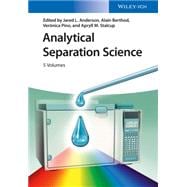Leading the way for analytical chemists developing new techniques.
This new comprehensive 5 volume set on separation science provides a much needed research-level text for both academic users and researchers who are working with and developing the most current methods, as well as serving as a valuable resource for graduate and post-graduate students.
Comprising of five topical volumes it provides a comprehensive overview of the subject, highlighting aspects that will drive research in this field in the years to come.
Volume 1: Liquid Chromatography
Volume 2: Special Liquid Chromatography Modes and Capillary Electromigration Techniques
Volume 3: Gas, Supercritical and Chiral Chromatography
Volume 4: Chromatographic and Related Techniques
Volume 5: Sample Treatment, Method Validation, and Applications
Key Features:
- Comprises over 2,100 pages in 5 volumes – available in print and online
- Edited by an international editorial team which has both prominent and experienced senior researchers as well as young and dynamic rising stars
- Individual chapters are labeled as either introductory or advanced, in order to guide readers in finding the content at the appropriate level
- Fully indexed with cross referencing within and between all 5 volumes








